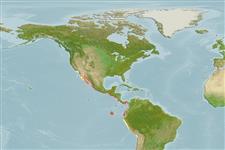Environment: milieu / climate zone / rango de profundidad / distribution range
Ecología
marino asociado a arrecife; rango de profundidad 3 - 50 m (Ref. 37955), usually 3 - 12 m (Ref. 2850). Tropical; 40°N - 20°S, 120°W - 70°W
Eastern Pacific: San Diego, California, USA to Peru, including the Galapagos Islands.
Tamaño / Peso / Age
Madurez: Lm ? range ? - ? cm
Max length : 25.4 cm TL macho / no sexado; (Ref. 5592); common length : 12.0 cm TL macho / no sexado; (Ref. 55763)
Short description
Claves de identificación | Morfología | Morfometría
Espinas dorsales (total) : 12 - 13; Radios blandos dorsales (total) : 18 - 20; Espinas anales: 3; Radios blandos anales: 15 - 17. Body deep, compressed, and disk-shaped; profile of head very steep and slightly concave; snout pronounced; teeth very small, setiform, and set in a comb-like band; base of pelvic spine with an axillary process; lateral line ending under last rays of dorsal fin; body creamy yellow with 5 or 6 dark vertical bars on the head, body and tail (Ref. 55763).
Body shape (shape guide): short and / or deep; Cross section: compressed.
Usually observed in pairs or small groups in rocky areas near the shore (Ref. 4858). Feed on algae and benthic invertebrates (Ref. 28023). Form schools with Chaetodipterus zonatus (Ref. 9286). Oviparous (Ref. 205). Form pairs during breeding (Ref. 205). Minimum depth reported from Ref. 5227.
Life cycle and mating behavior
Madurez | Reproducción | Puesta | Huevos | Fecundidad | Larva
Form pairs during breeding (Ref. 205). Monogamous mating is observed as both obligate and social (Ref. 52884).
Allen, G.R., 1985. Butterfly and angelfishes of the world. Vol. 2. 3rd edit. in English. Mergus Publishers, Melle, Germany. (Ref. 4858)
IUCN Red List Status (Ref. 130435: Version 2025-1)
Threat to humans
Harmless
Human uses
Pesquerías: comercial; Acuario: Comercial
Herramientas
Special reports
Download XML
Fuentes de Internet
Estimates based on models
Preferred temperature (Referencia
123201): 17.3 - 28.9, mean 25.2 °C (based on 231 cells).
Phylogenetic diversity index (Referencia
82804): PD
50 = 0.5000 [Uniqueness, from 0.5 = low to 2.0 = high].
Bayesian length-weight: a=0.02399 (0.01535 - 0.03748), b=3.04 (2.91 - 3.17), in cm total length, based on LWR estimates for this species & Genus-body shape (Ref.
93245).
Nivel trófico (Referencia
69278): 2.7 ±0.24 se; based on food items.
Resiliencia (Referencia
120179): Alto, población duplicada en un tiempo mínimo inferior a 15 meses (Preliminary K or Fecundity.).
Fishing Vulnerability (Ref.
59153): Low vulnerability (15 of 100).
🛈
Nutrients (Ref.
124155): Calcium = 76 [39, 117] mg/100g; Iron = 0.722 [0.445, 1.150] mg/100g; Protein = 18.5 [17.3, 19.6] %; Omega3 = 0.108 [0.069, 0.168] g/100g; Selenium = 36.6 [21.2, 67.2] μg/100g; VitaminA = 41.3 [11.4, 143.8] μg/100g; Zinc = 1.33 [0.92, 1.89] mg/100g (wet weight);
